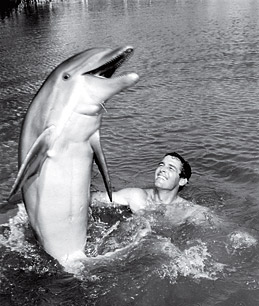
The Cove, a spectacularly compelling documentary that was as well financed as it is well intentioned, starts with a glimpse of seeming paranoia. A man in his late 60s is driving, anxiously checking his mirrors and talking about the people he’s sure are pursuing him. He’s wearing a surgical mask and gives the impression of Jason Bourne as a possibly batty senior citizen, still dodging bad guys and, maybe, swine flu. It turns out he’s Ric O’Barry, a forgotten face from 1960s pop culture. As a young man, he captured and trained Flipper–or rather, the five dolphins that played that beloved cetacean. He became a passionate opponent of keeping dolphins in captivity after the death of one of the Flippers, a bottlenose named Kathy. Now he’s a crusader on a mission: In a small, isolated cove in Taiji, Japan, where O’Barry has become a part-time resident , thousands of dolphins are being trapped and slaughtered every year. Since 2003, O’Barry has been desperately trying to expose and stop this legal but secretive practice. The irony is that O’Barry believes he’s partly to blame. The dolphins that are killed are the leftovers from searches to find performers for aquatic parks, places that might not exist if hadn’t been for Flipper mania. It’s a lucrative trade. O’Barry says a trained dolphin can sell for as much as $150,000. In Taiji, the public is welcome to watch the selection of dolphins by trainers. What most people aren’t allowed to see is what happens afterward, when the ones that didn’t make the cut are moved to the next rockbound inlet over and stabbed to death by fishermen. It’s legal to fish for dolphins in Japan, and the filmmakers estimate that 23,000 dolphins are “harvested” there annually. The dilemma faced by activists, including O’Barry, Greenpeace and, ultimately, the director of The Cove, Louie Psihoyos, was how to get visual evidence of these massacres to build support for protecting dolphins as whales are protected. The area is heavily guarded, by fishermen and police. Taking even a cliffside peek entails trespassing. A former National Geographic photographer who now leads the Oceanic Preservation Society, Psihoyos learned about Taiji from O’Barry in 2005. He was horrified. “I told him, We’ll fix this,” Psihoyos says. Easier said than done. But if O’Barry embodies guilt-ridden heartbreak , the tall and handsome Psihoyos is the picture of confidence. He’s also friends with Netscape billionaire Jim Clark, a very good thing to be if you’re trying to fund a documentary. Psihoyos refers to the team he recruits, which includes a moldmaker from Industrial Light & Magic and a pair of champion deep-sea free divers, as being like Ocean’s Eleven. He’s kidding. Sort of. The goal is a lot worthier than emptying the vault at a Las Vegas casino, but in terms of style, that’s what The Cove is emulating. Characters are introduced with a flourish–the daredevil, the soulful surfer, the bumbling cops–and Psihoyos takes the George Clooney role.